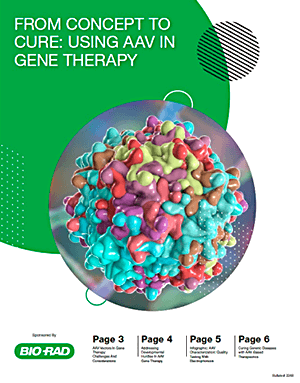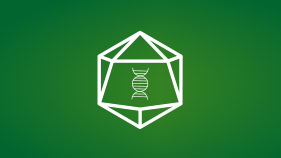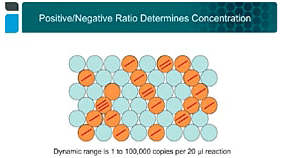
On This Page |
Advantages of AAV Gene Therapy | What are AAV Capsid Proteins | Measuring Purity | Determining Integrity | FAQs | Resources |

Free eBookFrom Concept to Cure: Using AAV in Gene Therapy
See various approaches to addressing AAV vector challenges, navigating the process of viral characterization, and learning how to overcome developmental hurdles in gene therapy.
Gene therapy was a hot field in the late 90’s until the unfortunate death of a clinical trial participant in an adenovirus study due to a high immune response. This led to an abundance of caution in use of viral vectors for gene therapy that remains to this day. Fortunately, Adenoassociated virus (AAV) was discovered to have significantly reduced to negligible immunogenicity along with an ability to infect nondividing cells. Currently, there are 11 discovered wild-type serotypes of AAV with differing tissue specificities and numerous recombinant AAV serotypes to expand the level of tissue specificity. AAV is one of the most widely used gene delivery vehicles for gene therapy because of its nonpathogenicity, low immunogenicity, and diverse tropism to multiple cell types.

Did you know?
AAV as a gene delivery vector makes up 26% of all ongoing gene therapy and cell-based Immuno-oncology clinical trials (1,093 in September 2022) and is the primary vector for in vivo gene therapy.
AAV Mediated Gene Therapy
AAV starts as a naturally occurring virus and is then transformed into a non-replicative vector with the purpose of curing diseases.
This replication-incompetent vector is engineered with new target DNA enabling it to be a precisely coded gene delivery vesicle.
Once engineered, the AAV vectors is then infused and delivers the required genetic modification to the right tissues or organs in the body
This is an example of an AAV gene replacement therapy. AAV gene therapies can also be used to reduce aberrant protein expression.
Advantages of AAV Gene Therapy
AAV Vector
High Transduction Efficiency
High levels of infectivity or transduction of genes up to 4 kbps which enables efficient replacement of missing or dysfunctional genes to produce a therapeutic effect in those with a genetic disorder.
Long-Term DNA Persistence
Maintains therapeutic levels of gene expression over a long period of time (years) in vivo in targeted tissue types.
What Are AAV Capsid Proteins?
AAV is composed of a protein shell called a capsid that encases 4.8 kb of single-stranded DNA. This viral capsid is made up of three main proteins, each of which is 87 kD (VP1), 73 kD (VP2), and 61 kD (VP3) in size and are different based on the serotype of the virus (vector). These capsid proteins also dictate the tissue specificity for infectivity.
Additionally, due to the inherent variability of biological systems, production of AAV can produce filled capsids, partially filled capsids, and empty capsids. If a batch of AAV production has a significant amount of partially filled or empty viral particles, then the transduction efficiency is reduced, and immune response can be increased. Therefore, characterization of these proteins and their ratios is critical for ensuring the quality, safety, and efficacy of AAV products.
|
|
|
|
|
|
|
|---|---|---|---|---|---|
| Causes |
Correct genome packaging |
Packaging of partial vector or host cell DNA |
No genome packaging |
Low stability and solubility in matrix |
Capsid with a contaminant fragment |
| Therapeutic effect |
Intended in vivo gene transfer |
Increases risk of immunotoxicity and reduces transduction |
|||
Identifying incorrectly filled capsids and aggregates necessitate upstream and downstream process optimization, as well as methods that enable the step-by-step analytical characterization of the virus, the results of which inform iterative refinement of production for yield, purity, and potency. The main issue here is the abundance of viral vector formulations, many of which require multiple analytical techniques for characterization.
Measuring Purity of Vectors
While AAV is normally thought to generate low to no immune response, the vector is generated using a biological system that generates biproducts during production of the vector. If the vector is not properly separated from these biproducts or contaminants, there can be an adverse response upon administration. Therefore, purity of the viral vector must be confirmed prior to administration in both preclinical and clinical trials.
For preclinical data, purity checks need to be quick and relatively cost effective. Upon moving to clinical trials, purity analysis will require a multitude of tests to ensure patient safety using techniques which measure host cell proteins (HCP), Host Cell DNA (HC DNA), and common contaminants.
Methods to measure purity include:
- SDS PAGE
- Capillary electrophoresis
- qPCR/Digital PCR
- ELISA
- HPLC
- Mass Spectrometry
Your need for speed, specificity, sensitivity, cost, and developmental timeline will dictate which solution is best.
| Benefit | SDS Page | Capillary Electrophoresis | qPCR or Digital PCR | ELISA | HPLC | Mass Spectrometry |
|---|---|---|---|---|---|---|
| Speed or throughput | Medium | High | High | Low | Medium | Low |
| Specificity | High | High | High | High | Low | High |
| Start-up and running cost | Low | High | Medium | Medium | High | High |
| Sensitivity | Medium | Medium | High | High | Medium | High |
| Ease of use | Easy | Medium | Medium | Hard | Medium | Hard |
Determining Integrity Using Capsid Ratios
An indicator that AAV capsids have been improperly formed is indicated by deviations of capsid protein ratios from the ideal state. Wild-type AAV serotypes have ratios that fall between (VP1:VP2:VP3)* 1:1:7 to 1:1:10 and recombinant serotype ratios must be tested and identified experimentally although most have been shown to fall within this range as well. Checking capsid protein ratios can be a quick technique to verify the intactness of the population of AAV viral particles and therefore indicative of their transduction efficiency.
Diagram of the recombinant AAV genome
Methods to measure protein capsid ratios include:
- SDS PAGE
- Capillary electrophoresis
How to Quickly Calculate AAV Capsid Protein Ratios Using Image Lab Software
Watch this Image Lab video tutorial on how to assess AAV capsid protein ratios as a fast quality control step in gene therapy development and manufacturing and download the Quick Guide to follow along.
Download a printable quick guide and to learn more about AAV capsid purity, integrity, and identity.
Measuring Integrity of Viral Vectors
| Benefit | SDS Page | Capillary Electrophoresis |
|---|---|---|
| Speed or throughput | Medium | High |
| Specificity | High | High |
| Speed or throughput | Medium | High |
| Start-up and running costs | Low | High |
| Sensitivity | Medium | Medium |
| Ease of use | Easy | Medium |
Confirming Identity of Serotypes
As AAV vectors are proceeding through development and characterization, periodic checks are needed to ensure the serotype is correct. There are multiple wild-type AAV serotypes and research is ongoing to enhance target tissue or cell specificity.
To confirm product identity, immunoassays are typically used with antibodies specific to the serotype being investigated. Western blot techniques are commonly used to confirm product identity in early stage or preclinical development due to its low start-up and running cost as well as ease of use. When sample amounts require higher throughout and less human manipulation, enzyme linked immunosorbent assay (ELISA) is often the technique chosen.
Western blotting and ELISA immunoassays detect and quantify a specific protein in a complex mixture using chromogenic, fluorescent or luminescent readouts. The principal advantage of western blotting over ELISA is its specificity; since the proteins in the mixture are first separated according to physical properties, it is less likely to give false positive results.
Methods to measure serotype identity include:
- Western blotting
- ELISA
| Benefit | Western Blotting | ELISA |
|---|---|---|
| Speed | Medium | Low |
| Throughput | Low | High |
| Specificity | High | High |
| Cost start-up and running cost | Low | Medium |
| Sensitivity | Medium | High |
| Ease of use | Easy | Hard |
Frequently Asked Questions
Why should I consider AAV in my therapeutic?
What causes increased risk of cytotoxicity in my AAV therapeutic?
Is it necessary to review the integrity of my AAV vector?
At what point during my AAV workflow should I perform these qualitative checks?
What considerations must be taken in GMP or QC environments?
Resources
Webinars
-
Introduction to Droplet Digital™ PCR: Workflow and Applications
Learn the concept, workflow, and diverse applications of ddPCR™ technology showcased in recent journal publications.
Publications
Systemic Treatment of Fabry Disease Using a Novel AAV9 Vector Expressing α-Galactosidase A
Biferi MG, et al. Mol Ther Methods Clin Dev. 2020 Oct 22;20:1-17. doi: 10.1016/j.omtm.2020.10.016
Hair Cell Transduction Efficiency of Single- and Dual-AAV Serotypes in Adult Murine Cochleae
Omichi R, et al. Mol Ther Methods Clin Dev. 2020 May 13;17:1167-1177. doi: 10.1016/j.omtm.2020.05.007
Documents
-
Transitioning Your Assay from Quantitative PCR to Droplet Digital PCR
Learn how transitioning your assay from qPCR to ddPCR technology can be simple and provide consistent results.
-
ddPCR Assays for Adeno-Associated Virus (AAV) Vector Genome Titer
Discover the complete ddPCR technology workflow solution for absolute quantification of AAV vector genome copies.
-
ddPCR Viral Quantification: Success Story
Read this success story on how ddPCR technology represents a highly precise method for determining AAV vector genome titers.
References
- François A, et al. Accurate Titration of Infectious AAV Particles Requires Measurement of Biologically Active Vector Genomes and Suitable Controls. Mol Ther Methods Clin Dev. 2018 Jul 27;10:223-236. doi: 10.1016/j.omtm.2018.07.004. PMID: 30112419.
- Guo P, et al. Rapid and Simplified Purification of Recombinant Adeno-Associated Virus. J Virol Methods. 2012 Aug;183(2):139-46. doi: 10.1016/j.jviromet.2012.04.004. Epub 2012 Apr 26. PMID: 22561982.
Ready to learn how Bio-Rad can help with viral purity and integrity? Our scientists are here to help.
Discover More Gene Therapy Development Solutions
-

Viral Titer Determination
Switch to ddPCR technology for viral titer determination or upgrade to an easy-to-use, high-performance ddPCR platform for your gene therapy workflows.
-

Viral Vector Characterization
Enable efficient and accurate characterization of your viral vector with our full workflow of products, whether your gene therapy uses AAV or another vector technology.
-

Viral Vector QC
Harness the power of ddPCR technology for accurate and precise detection and quantification of host cell DNA and pathogenic microbes.




